A Circular-Arc-Type Magnetic Coupler with Strong Misalignment Tolerance for AUV Wireless Charging System
Abstract
:1. Introduction
2. Novel Magnetic Coupler Structure Design
2.1. Proposal of Magnetic Coupler
- Adaptability: The performance of WPT is closely related to the air gap between the transmitter and the receiver. In general, the AUV is a torpedo-like cylinder with an arcuate surface, the shape of the magnetic coupler should be designed to adapt the AUV surface as closely as possible to reduce the distance between the transmitter and the receiver;
- Lightweight and electromagnetic compatibility: AUVs usually need to carry out long-term marine tasks. In order to achieve rapid movement in the water, it is necessary to design magnetic couplers to meet the requirements of lightweight. Mn-Zn ferrite is widely used as the core material of WPT. Although the use of ferrite increases the weight, it can reduce the number of wires used in the magnetic coupler, and the whole system does not be heavier. The effect of lightweight can be further achieved by reducing the use of ferrite core in AUV. In addition, a large number of electronic devices such as sonar, GPS, and other communication systems are assembled inside the AUV. Therefore, to ensure that wireless energy transmission can be realized without affecting the normal use of AUV, electromagnetic compatibility (EMC) should be considered in the design of the coupler;
- Misalignment tolerance: AUV is slightly misaligned during the actual underwater environment charging process, which is affected by docking accuracy and ocean current, and the AUV itself cannot correct such positional changes. Although the docking station is usually equipped with a mechanical clamping device, there is still a small range of misalignment for AUVs. Therefore, it is necessary to consider the misalignment tolerance in the coupler design process.
2.2. CA-Type Magnetic Coupler Dimension Optimization
3. Theoretical Analysis of Wireless Charging System
4. Finite Element Analysis for Misalignment Tolerance of Magnetic Coupler
4.1. Influence of Misalignment on Mutual Inductance and Coupling Coefficient
4.2. Influence of Docking Misalignment on Transmission Efficiency and Output Power
4.3. Compared with Previous Research on Magnetic Coupler of AUV WCS
5. Experimental Verification
6. Conclusions
Author Contributions
Funding
Institutional Review Board Statement
Informed Consent Statement
Data Availability Statement
Conflicts of Interest
References
- Page, B.R.; Mahmoudian, N. Simulation-Driven Optimization of Underwater Docking Station Design. IEEE J. Ocean. Eng. 2020, 45, 404–413. [Google Scholar] [CrossRef]
- Wu, X.; Sun, P.; Yang, S.; He, L.; Cai, J. Review on Underwater Wireless Power Transfer Technology and Its Application. Trans. China Electrotech. Soc. 2019, 34, 1559–1568. [Google Scholar]
- Tamura, M.; Murai, K.; Matsumoto, M. Design of disposable film-type capacitive wireless charging for implantable medical devices. In Proceedings of the 2021 IEEE MTT-S International Microwave Symposium (IMS), Atlanta, GA, USA, 7–25 June 2021; pp. 58–61. [Google Scholar]
- Akhil, A.G.; Harisankar, S.; Jishnu, K.; Sreenand, S.; Vijay, V.; Asha, C.A.; Preetha, P.K. Coupled Wireless Charging system for Electric Vehicles. In Proceedings of the 2021 Third International Conference on Intelligent Communication Technologies and Virtual Mobile Networks (ICICV), Tirunelveli, India, 4–6 February 2021; pp. 475–479. [Google Scholar]
- Campi, T.; Cruciani, S.; Maradei, F.; Feliziani, M. Wireless charging system integrated in a small unmanned aerial vehicle (UAV) with high tolerance to planar coil misalignment. In Proceedings of the EMC Sapporo/APEMC, Sapporo, Japan, 3–7 June 2019; pp. 601–604. [Google Scholar]
- Zhao, Z.; Zhang, Y.; Chen, K. New Progress of Magnetically-coupled Resonant Wireless Power Transfer Technology. Proc. Chin. Soc. Electr. Eng. 2013, 33, 1–13. [Google Scholar]
- Park, C.; Lee, S.; Jeong, S.Y.; Cho, G.; Rim, C.T. Uniform Power I Type Inductive Power Transfer System With DQ-Power Supply Rails for On-Line Electric Vehicles. IEEE Trans. Power Electron. 2015, 30, 6446–6455. [Google Scholar] [CrossRef]
- Zhang, X.; Wang, Z.; Wei, B.; Wang, S.; Yang, Q. Analysis of the Influence of Electric Shield on Space Magnetic Field in Electric Vehicle Wireless Charging System. Trans. China Electrotech. Soc. 2019, 34, 1580–1588. [Google Scholar]
- Azad, A.; Tavakoli, R.; Pratik, U.; Varghese, B.; Coopmans, C.; Pantic, Z. A Smart Autonomous WPT System for Electric Wheelchair Applications with Free-Positioning Charging Feature. IEEE J. Emerg. Sel. Top. Power Electron. 2020, 8, 3516–3532. [Google Scholar] [CrossRef]
- Barzegaran, M.R.; Zargarzadeh, H.; Mohammed, O.A. Wireless Power Transfer for Electric Vehicle Using an Adaptive Robot. IEEE Trans. Magn. 2017, 53, 7205404. [Google Scholar] [CrossRef]
- Zhang, W.; Mi, C.C. Compensation Topologies of High-Power Wireless Power Transfer Systems. IEEE Trans. Veh. Technol. 2016, 65, 4768–4778. [Google Scholar] [CrossRef]
- Kamineni, A.; Neath, M.J.; Covic, G.A.; Boys, J.T. A Mistuning-Tolerant and Controllable Power Supply for Roadway Wireless Power Systems. IEEE Trans. Power Electron. 2017, 32, 6689–6699. [Google Scholar] [CrossRef]
- Cheng, Z.; Lei, Y.; Song, K.; Zhu, C. Design and loss analysis of loosely coupled transformer for an underwater high-power inductive power transfer system. IEEE Trans. Magn. 2015, 51, 8401110. [Google Scholar]
- Kan, T.; Zhang, Y.; Yan, Z.; Mercier, P.P.; Mi, C.C. A rotation-resilient wireless charging system for lightweight autonomous underwater vehicles. IEEE Trans. Veh. Technol. 2018, 67, 6935–6942. [Google Scholar] [CrossRef]
- Wang, D.; Cui, S.; Zhang, J.; Bie, Z.; Song, K.; Zhu, C. A Novel Arc-Shaped Lightweight Magnetic Coupler for AUV Wireless Power Transfer. IEEE Trans. Ind. Appl. 2022, 58, 1315–1329. [Google Scholar] [CrossRef]
- Yan, Z.; Zhang, Y.; Zhang, K.; Song, B.; Mi, C. Underwater wireless power transfer system with a curly coil structure for AUVs. IET Power Electron. 2019, 12, 2559–2565. [Google Scholar] [CrossRef] [Green Version]
- Cai, C.; Qin, M.; Wu, S.; Yang, Z. A strong misalignment tolerance magnetic coupler for autonomous underwater vehicle wireless power transfer system. In Proceedings of the 2018 IEEE International Power Electronics and Application Conference and Exposition, Shenzhen, China, 4–7 November 2018; pp. 1–5. [Google Scholar]
- Shi, J.; Li, D.; Yang, C. Design and analysis of an underwater inductive coupling power transfer system for autonomous underwater vehicle docking applications. J. Zhejiang Univ. Sci. C 2014, 15, 51–62. [Google Scholar] [CrossRef]
- Lin, M.; Li, D.; Yang, C. Design of an ICPT system for battery charging applied to underwater docking systems. Ocean. Eng. 2017, 145, 373–381. [Google Scholar] [CrossRef]
- Cai, C.; Zhang, Y.; Wu, S.; Liu, J.; Zhang, Z.; Jiang, L. A circumferential coupled dipole-coil magnetic coupler for autonomous underwater vehicles wireless harging applications. IEEE Access 2020, 8, 65432–65442. [Google Scholar] [CrossRef]
- Kan, T.; Mai, R.; Mercier, P.P.; Mi, C.C. Design and analysis of a three-phase wireless charging system for lightweight autonomous underwater vehicles. IEEE Trans. Power Electron. 2018, 33, 6622–6632. [Google Scholar] [CrossRef]
- Wu, S.; Cai, C.; Wang, A.; Qin, Z.; Yang, S. Design and Implementation of a Uniform Power and Stable Efficiency Wireless Charging System for Autonomous Underwater Vehicles. IEEE Trans. Ind. Electron. 2022, 99, 1–10. [Google Scholar] [CrossRef]
- Cai, C.; Wu, S.; Zhang, Z.; Jiang, L.; Yang, S. Development of a Fit-to-Surface and Lightweight Magnetic Coupler for Autonomous Underwater Vehicle Wireless Charging Systems. IEEE Trans. Power Electron. 2021, 36, 9927–9940. [Google Scholar] [CrossRef]
- Budhia, M.; Covic, G.A.; Boys, J.T. Design and optimization of circular magnetic structures for lumped inductive power transfer systems. IEEE Trans. Power Electron. 2011, 26, 3096–3108. [Google Scholar] [CrossRef]
- Song, K.; Li, Z.; Jiang, J.; Zhu, C. Constant Current/Voltage Charging Operation for Series-Series and Series-Parallel Compensated Wireless Power Transfer Systems Employing Primary-Side Controller. IEEE Trans. Power Electron. 2018, 33, 8065–8080. [Google Scholar] [CrossRef]
- Alkasir, A.; Abdollahi, S.E.; Abdollahi, S.R.; Wheeler, P. A Primary Side CCS-MPC Controller for Constant Current/Voltage Charging Operation of Series-Series Compensated Wireless Power Transfer Systems. In Proceedings of the 2021 12th Power Electronics, Drive Systems, and Technologies Conference (PEDSTC), Tabriz, Iran, 2–4 February 2021; pp. 1–5. [Google Scholar]
- Dongming, G.; Dangshu, W. Research on Transmission Characteristics of Dual LCL Resonance Compensation Topology in Wireless Charging System. In Proceedings of the 2021 IEEE 5th Information Technology, Networking, Electronic and Automation Control Conference (ITNEC), Xi’an, China, 15–17 October 2021; pp. 185–189. [Google Scholar]
- Li, Z.; Zhu, C.; Jiang, J.; Song, K.; Wei, G. A 3-kW Wireless Power Transfer System for Sightseeing Car Supercapacitor Charge. IEEE Trans. Power Electron. 2017, 32, 3301–3316. [Google Scholar] [CrossRef]
- Yan, Z.; Zhang, Y.; Song, B.; Zhang, K.; Kan, T.; Mi, C. An LCC-P compensated wireless power transfer system with a constant current output and reduced receiver size. Energies 2019, 12, 172. [Google Scholar] [CrossRef] [Green Version]
- Wang, Y.; Mai, J.; Yao, Y.; Xu, D. Analysis and Design of an IPT System Based on S/SP Compensation with Improved Output Voltage Regulation. IEEE Trans. Ind. Inform. 2020, 16, 3256–3266. [Google Scholar] [CrossRef]
- Qiao, K.; Sun, P.; Rong, E.; Sun, J.; Zhou, H.; Wu, X. Anti-misalignment and lightweight magnetic coupler with H-shaped receiver structure for AUV wireless power transfer. IET Power Electron. 2022, 15, 1843–1857. [Google Scholar] [CrossRef]
- Kojiya, T.; Sato, F.; Matsuki, H.; Sato, T. Automatic power supply system to underwater vehicles utilizing non-contacting technology. In Proceedings of the Oceans MTS/IEEE Techno-Ocean, Kobe, Japan, 9–12 November 2004; Volume 4, pp. 2341–2345. [Google Scholar]
- Yan, Z.; Zhang, Y.; Kan, T.; Lu, F.; Zhang, K.; Song, B.; Mi, C.C. Frequency optimization of a loosely coupled underwater wireless power transfer system considering eddy current loss. IEEE Trans. Ind. Electron. 2019, 66, 3468–3476. [Google Scholar] [CrossRef]


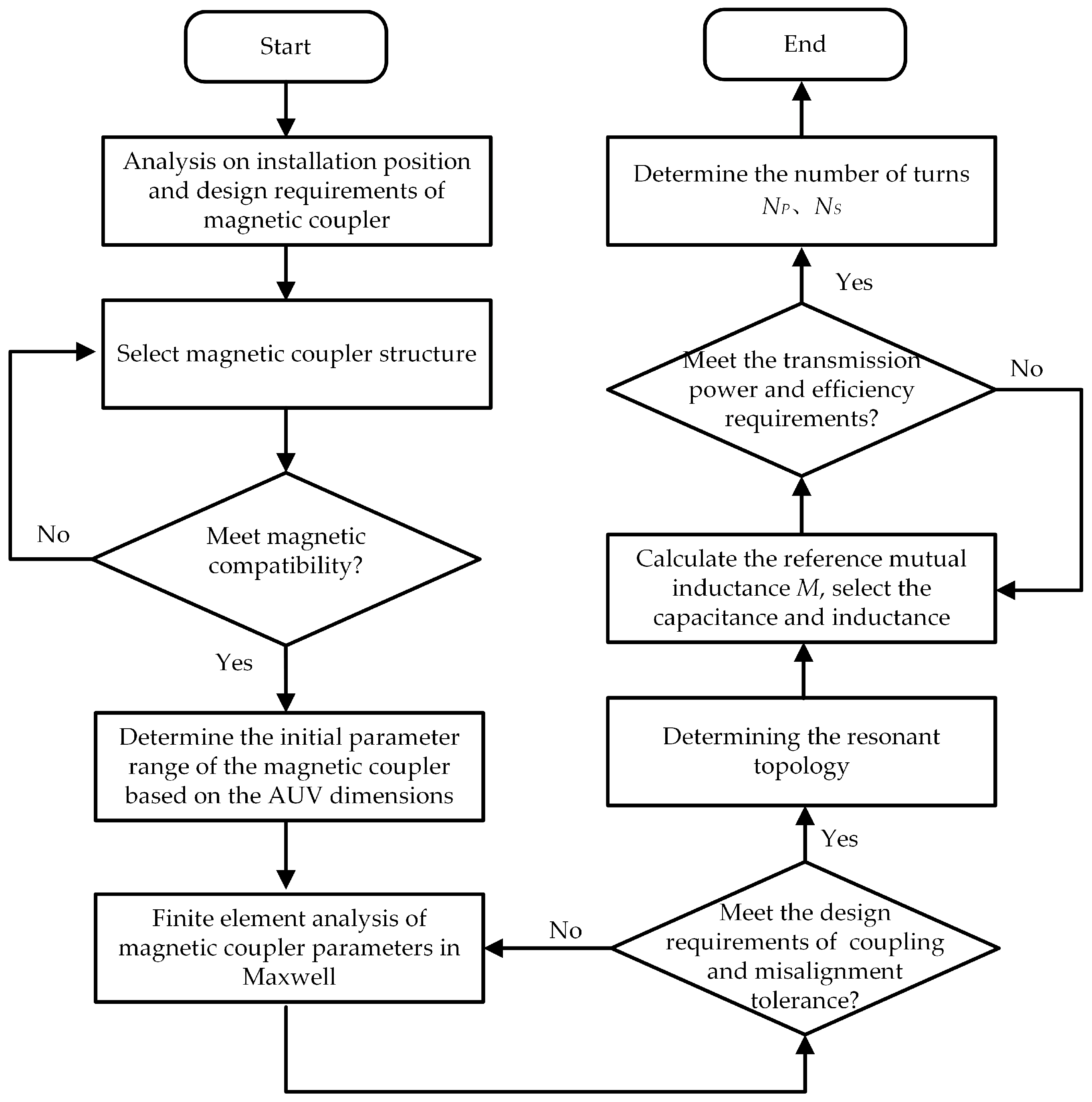


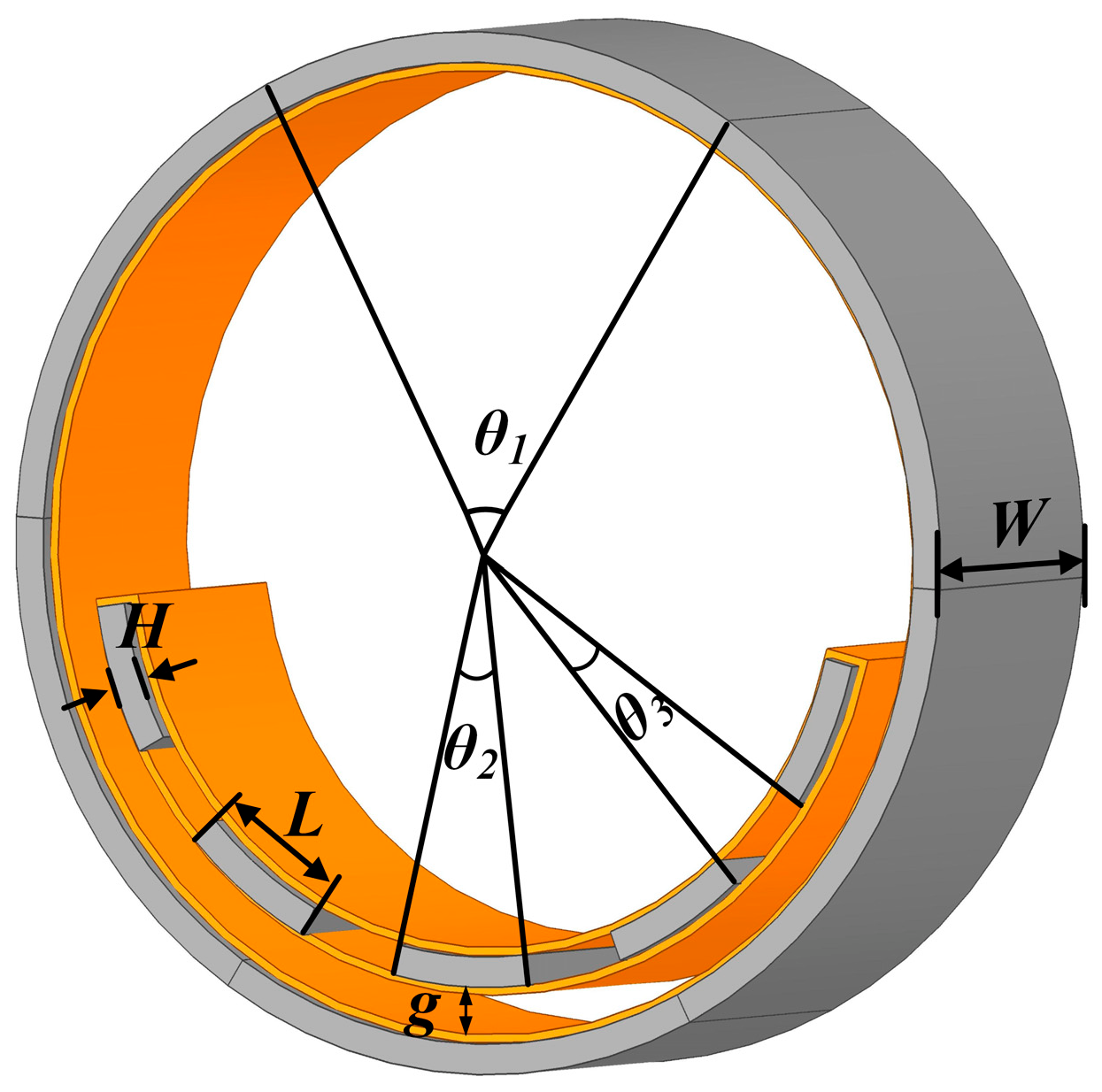
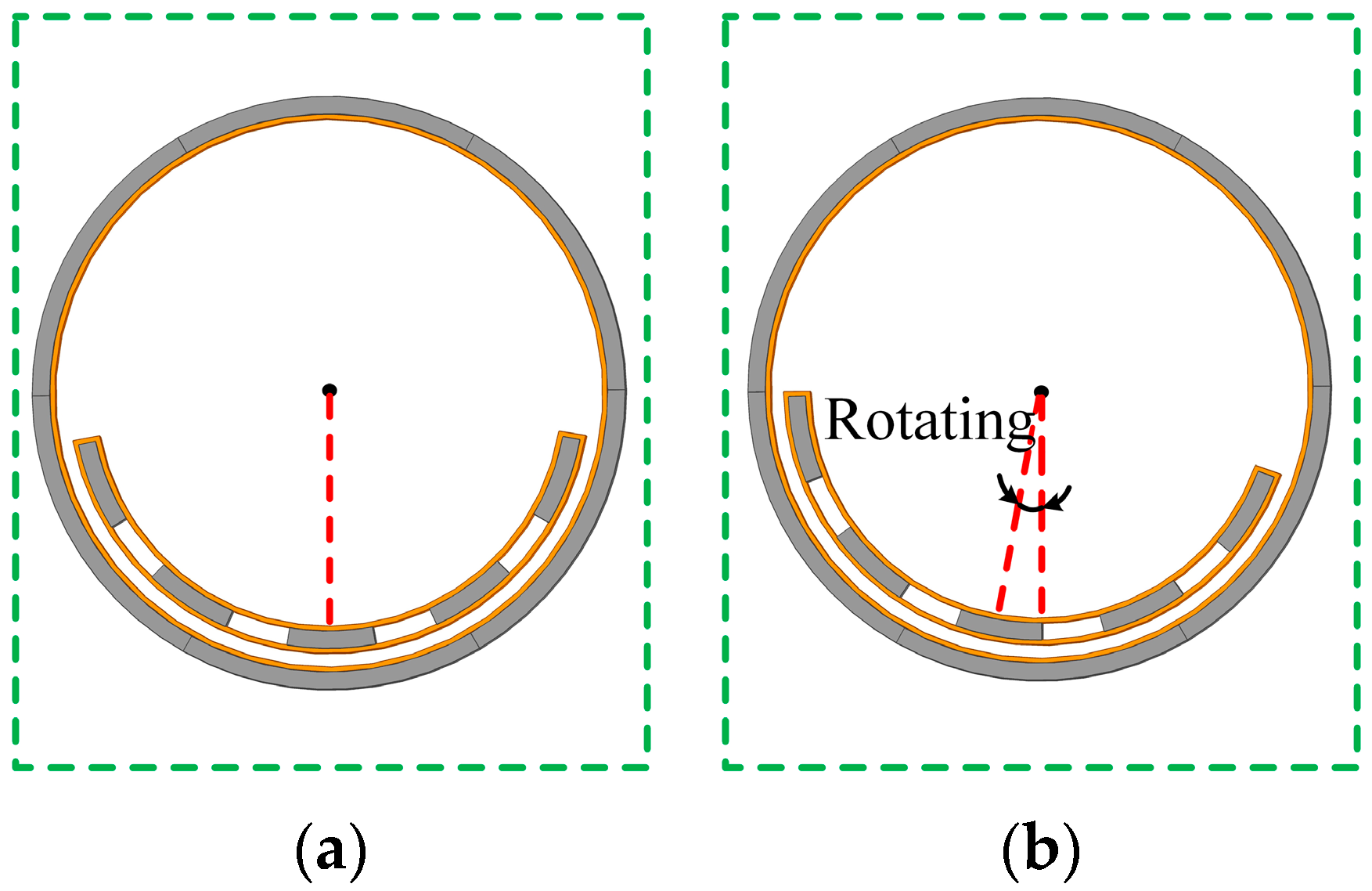
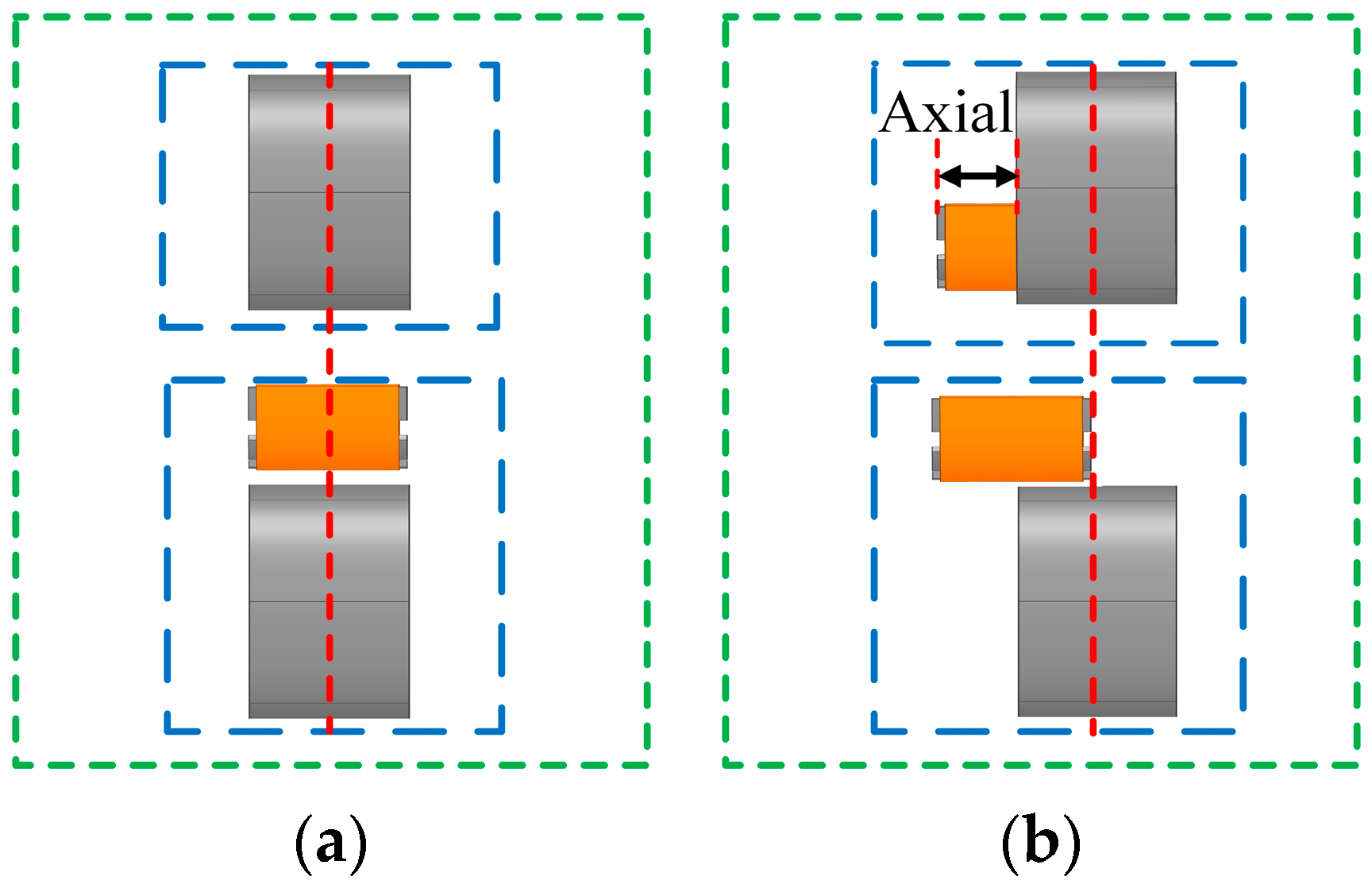
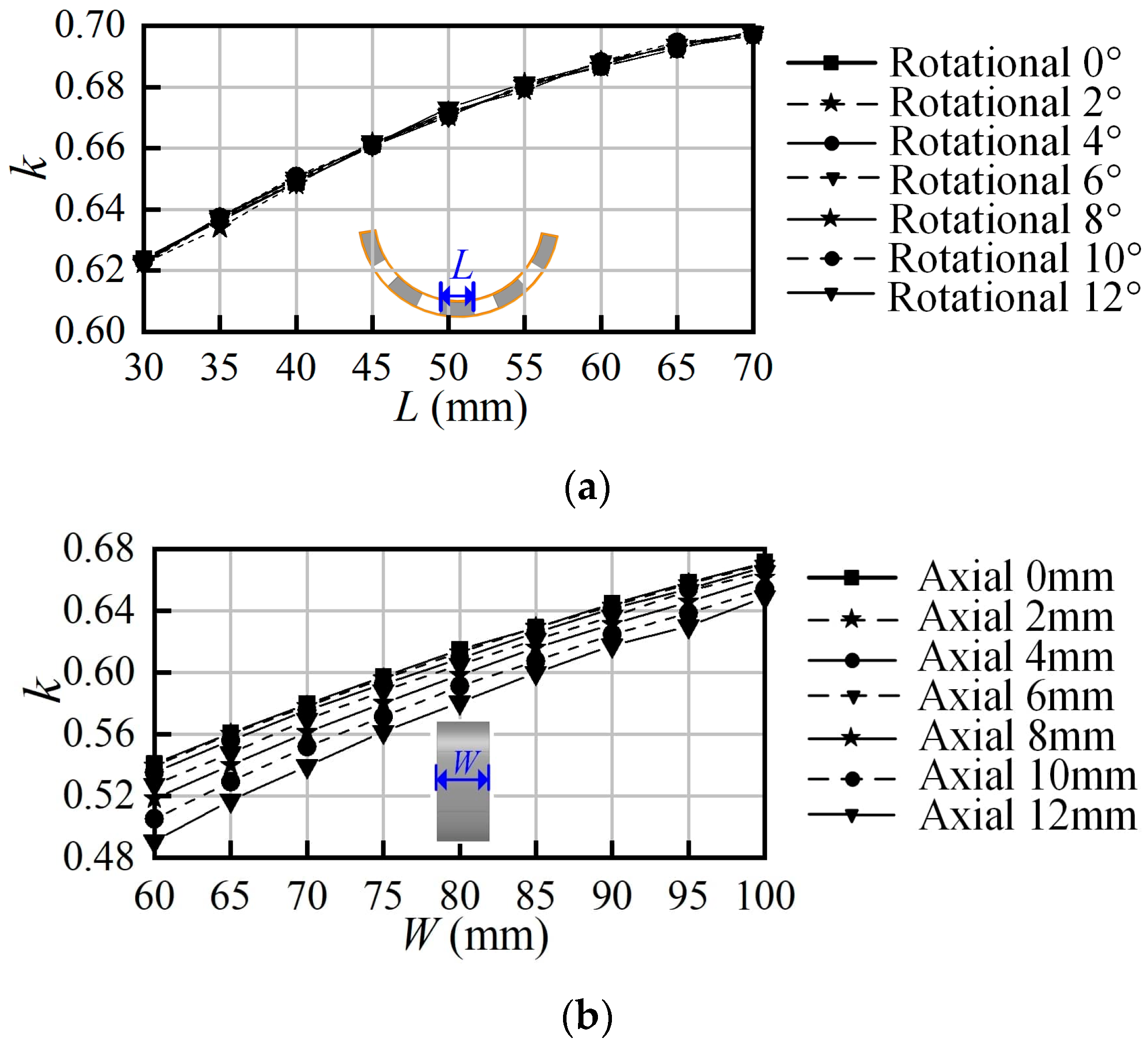
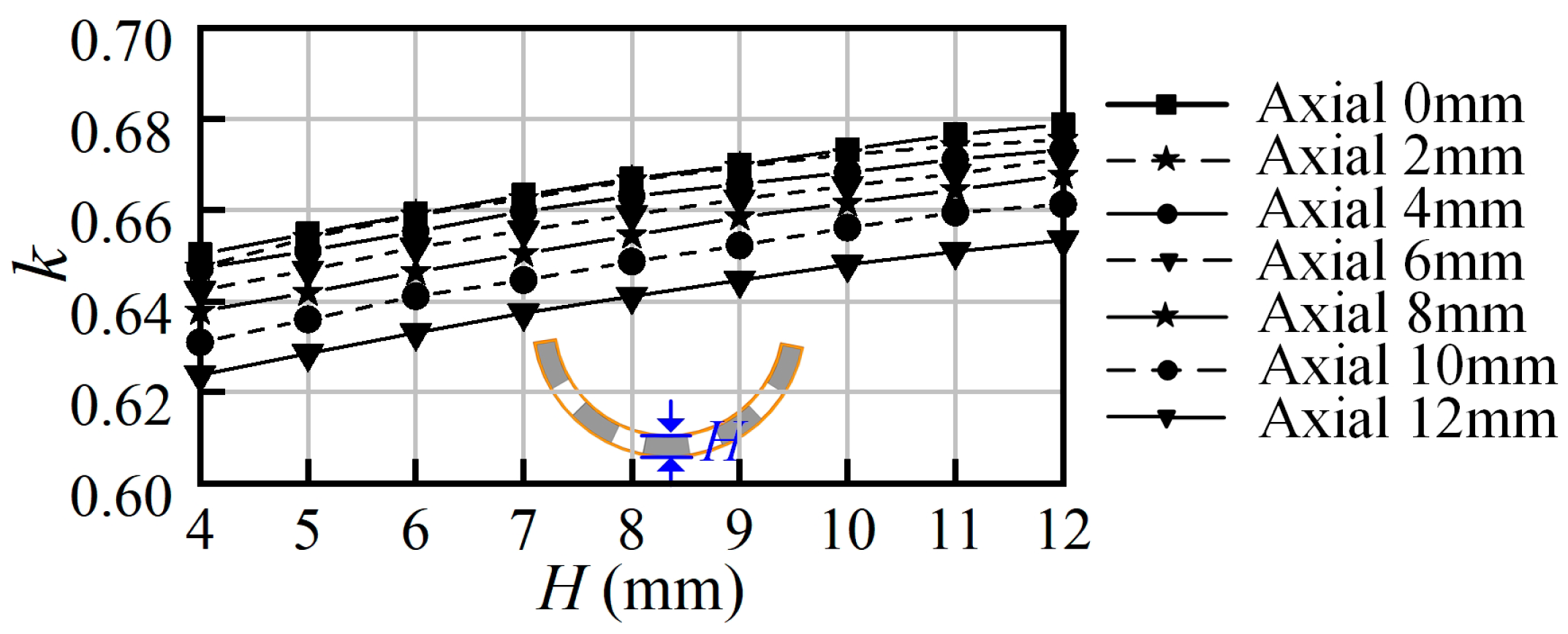
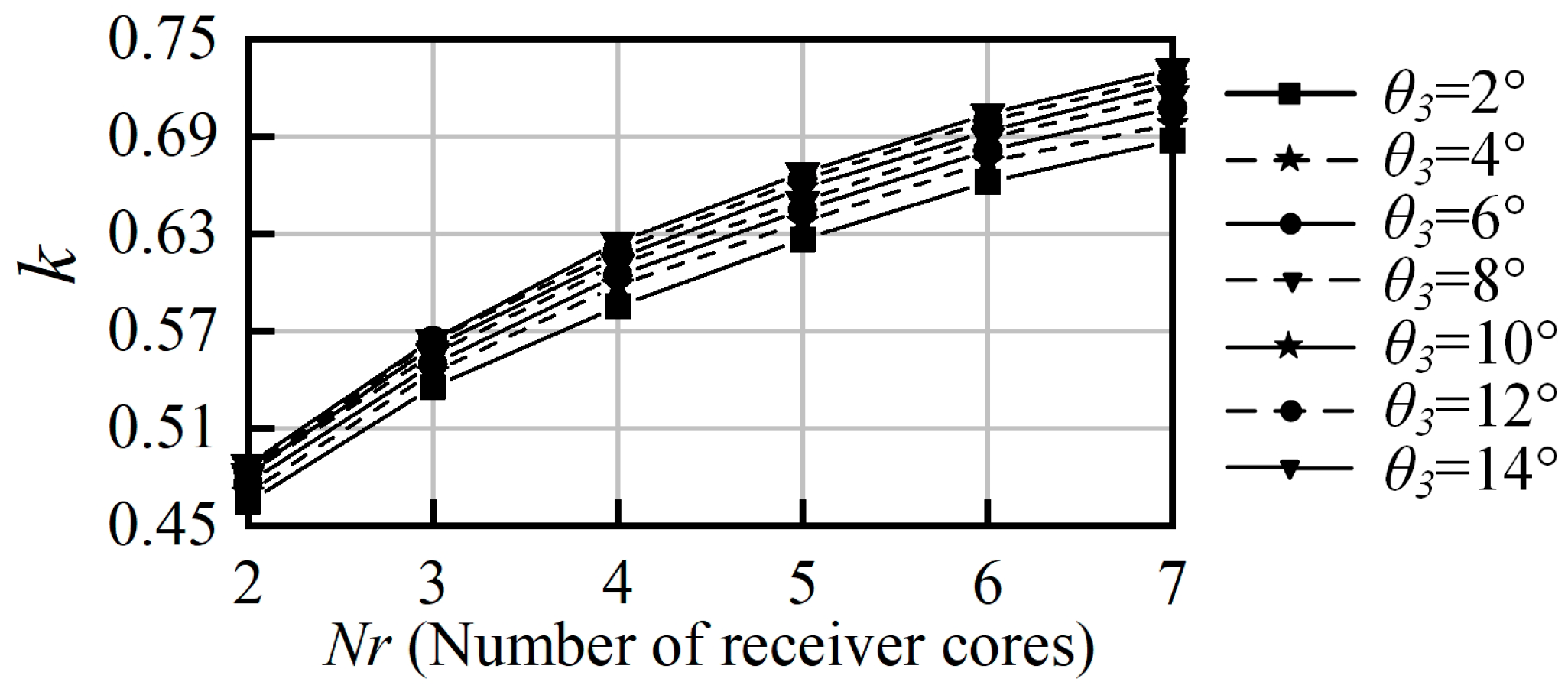
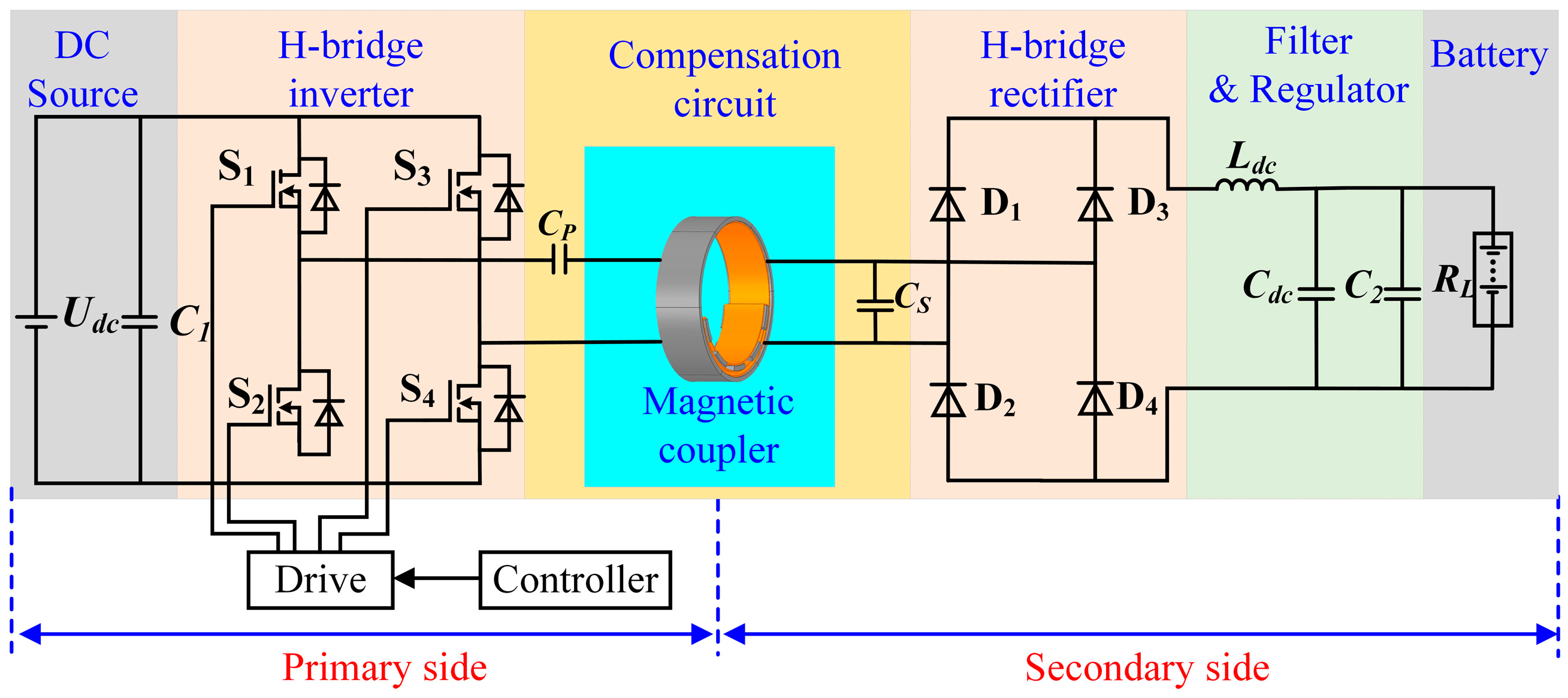
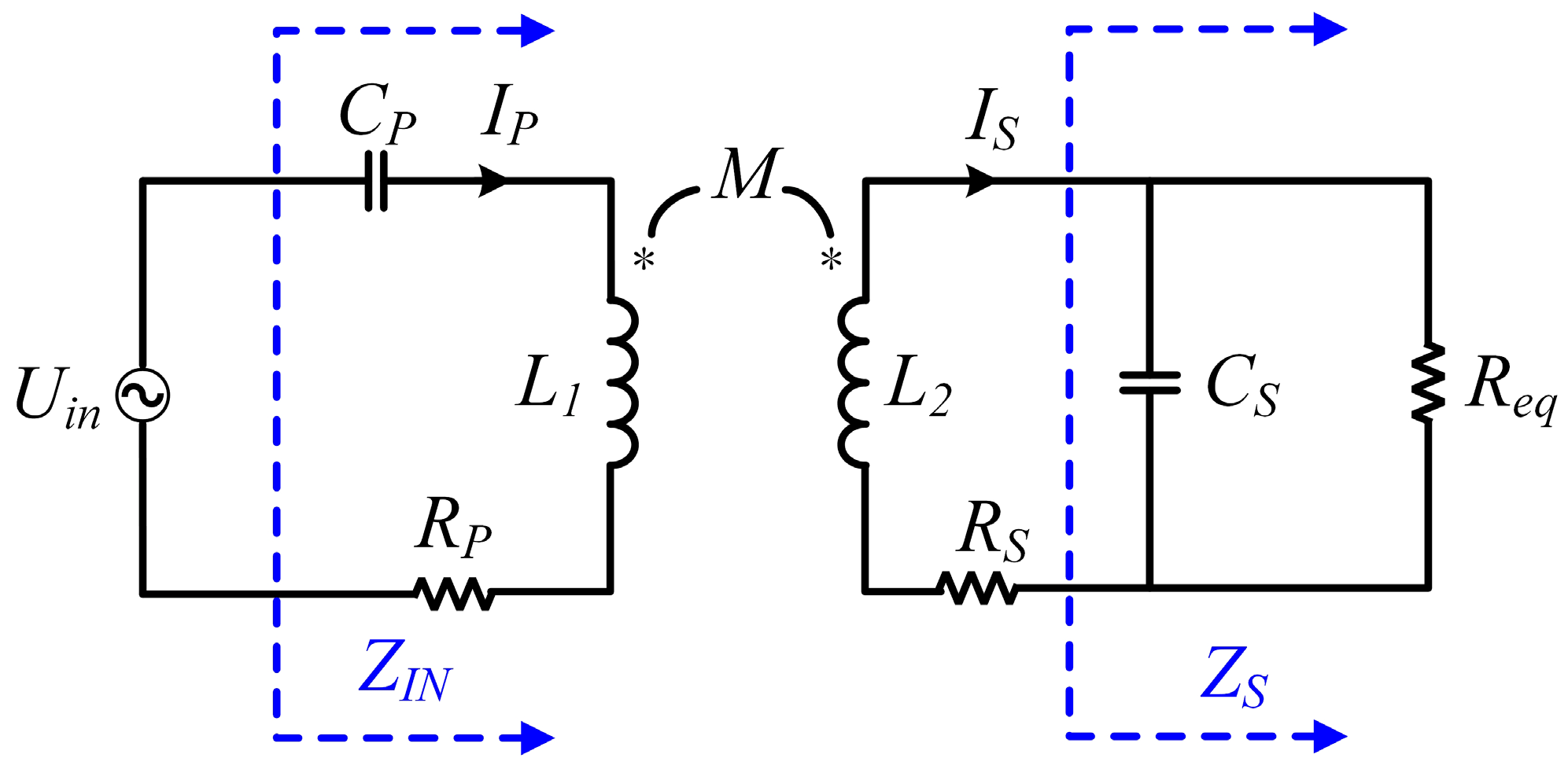
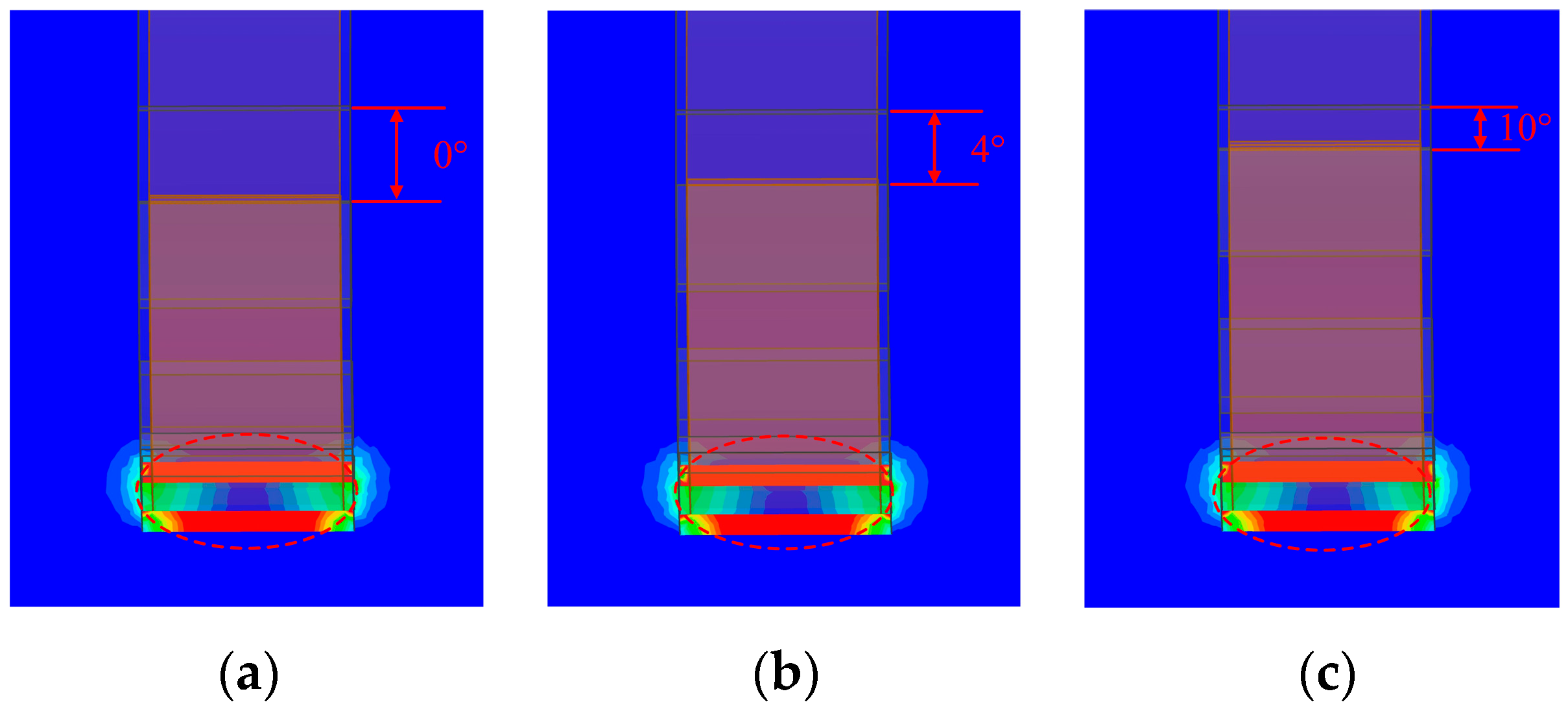
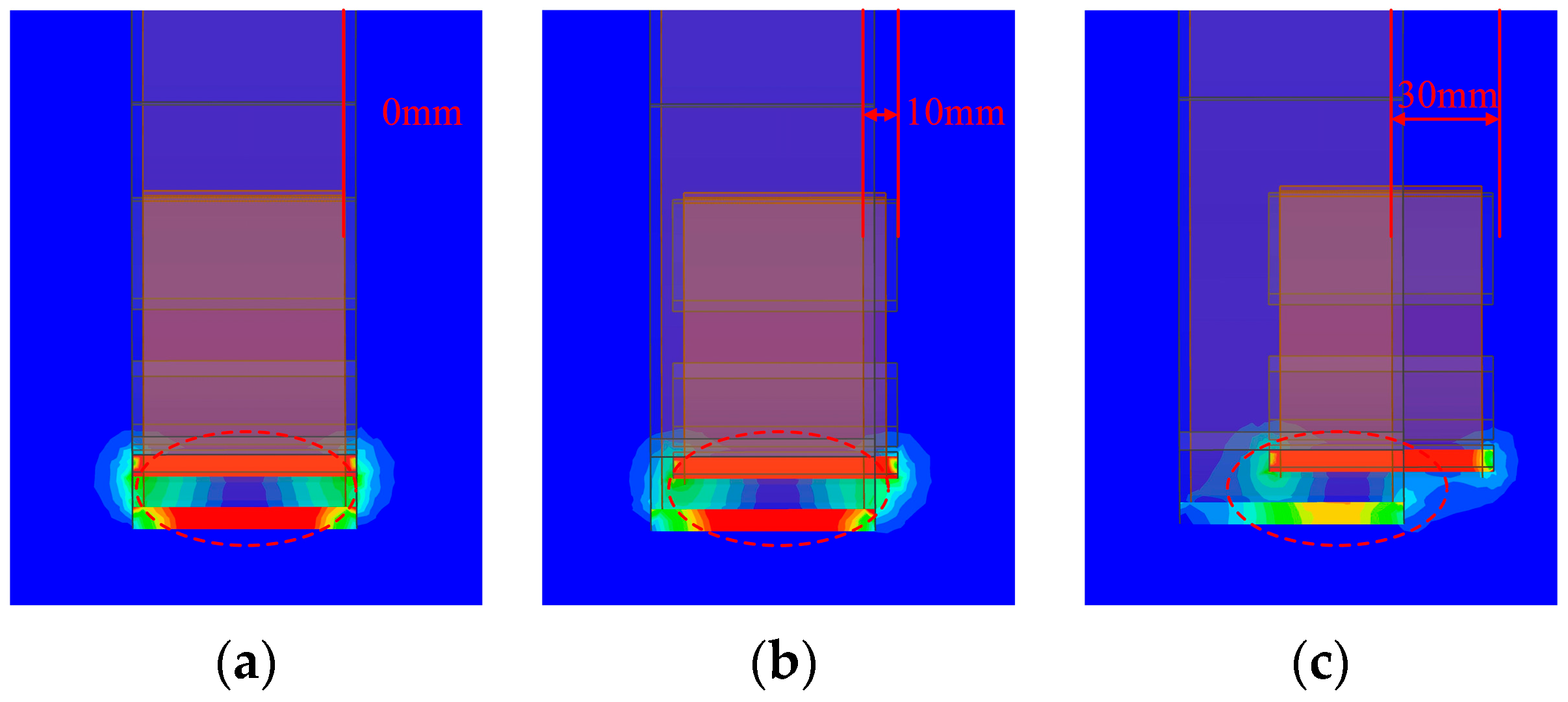
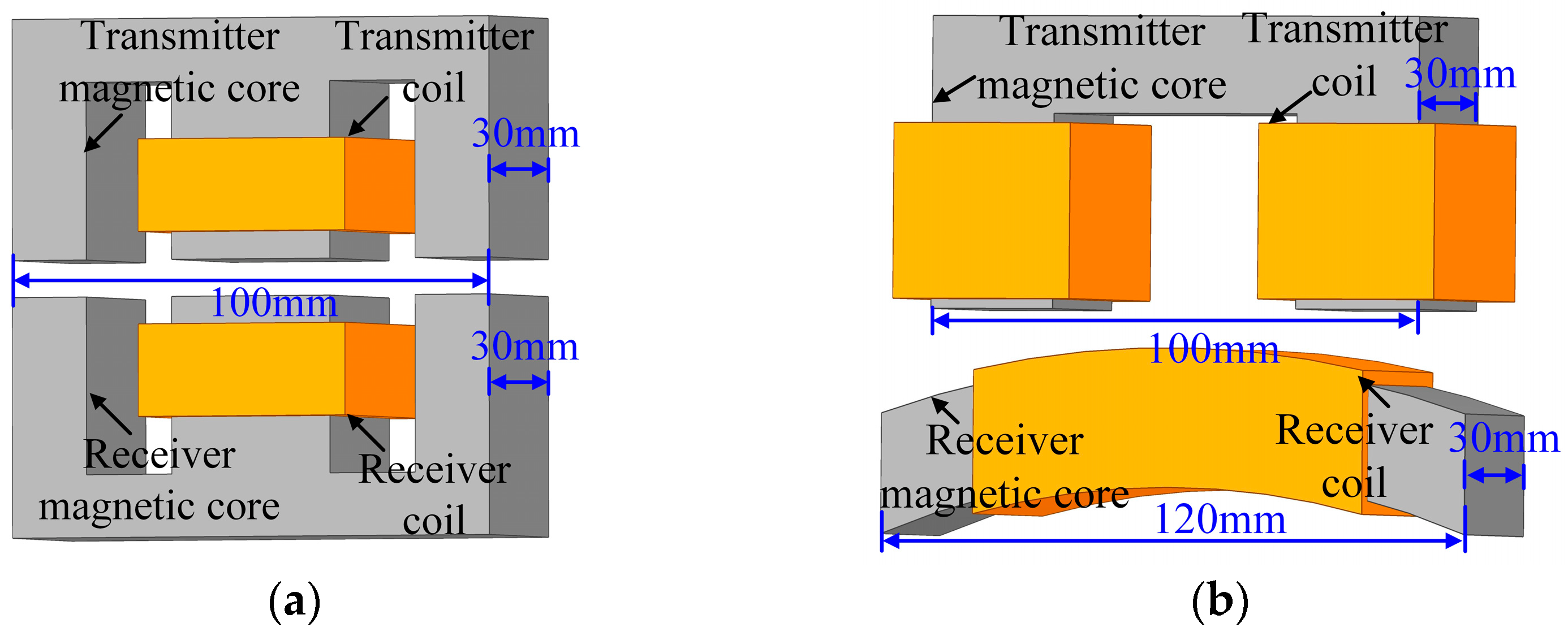




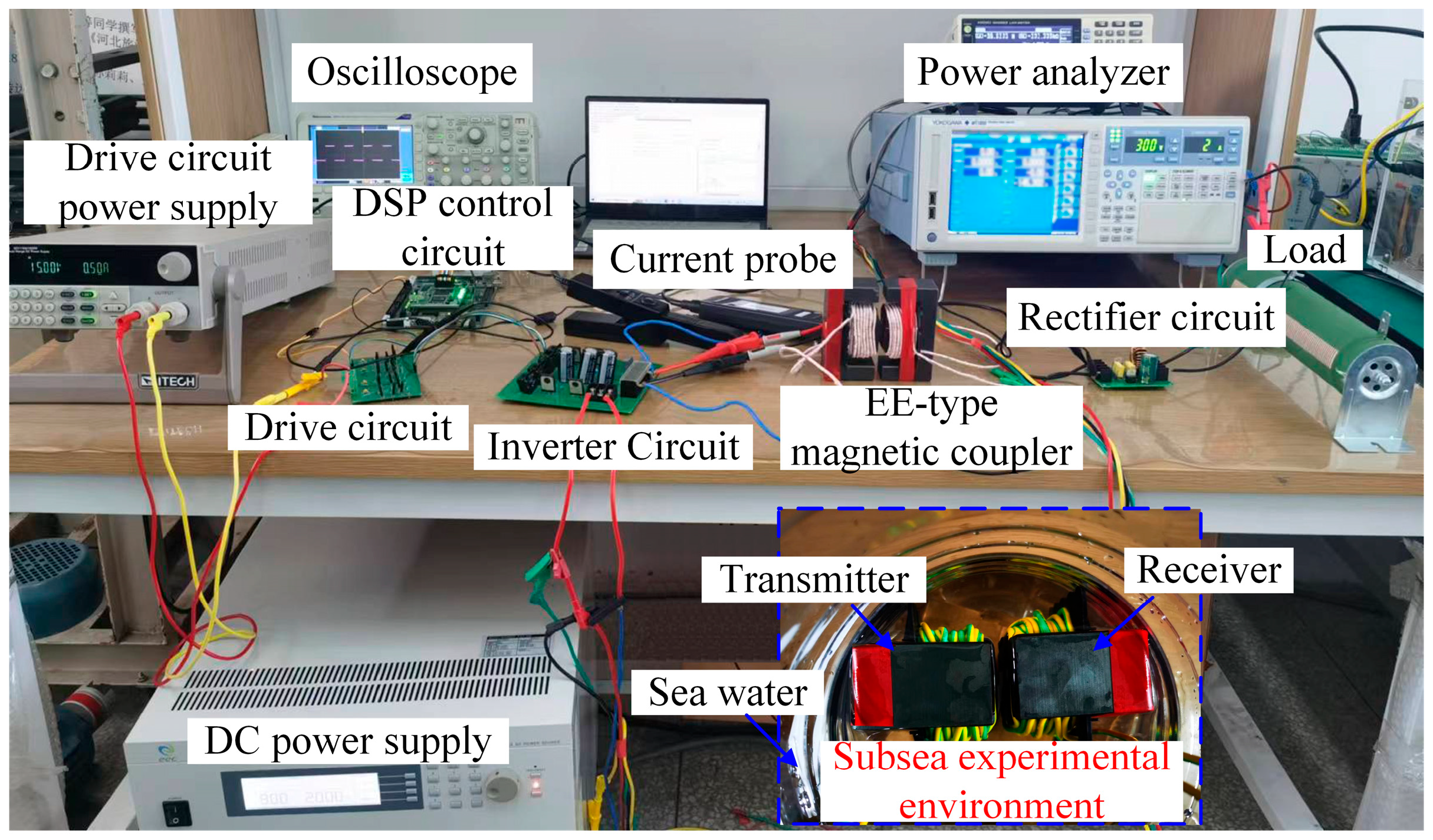


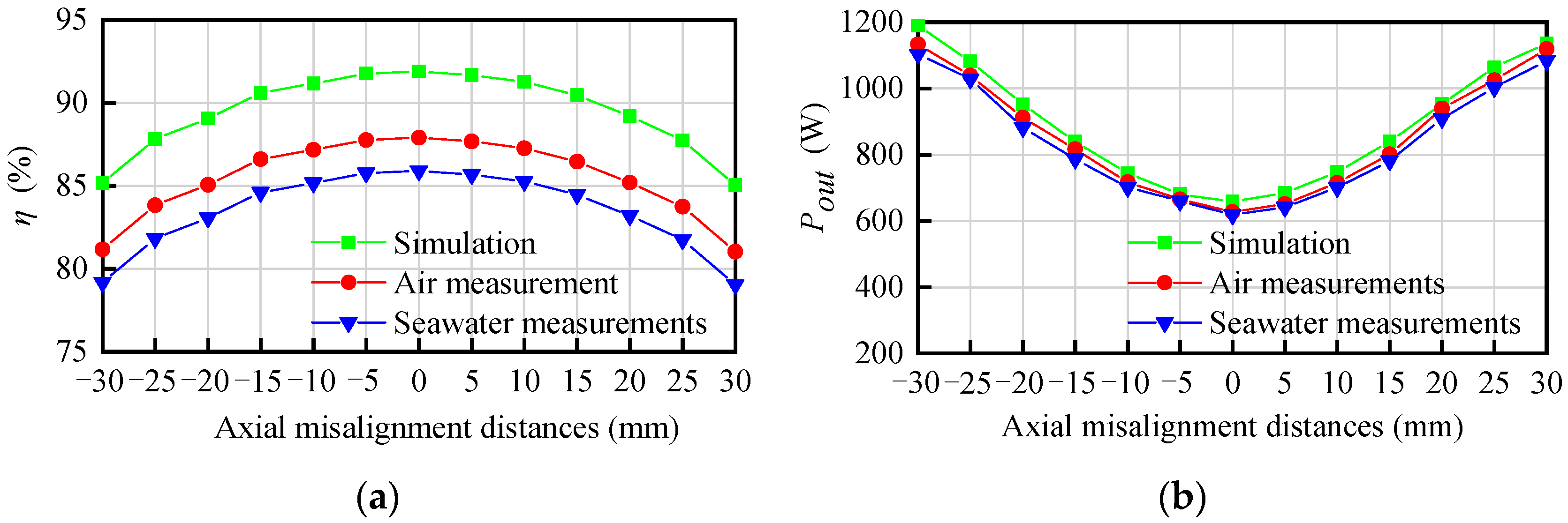
| Symbol | Parameter | Value |
|---|---|---|
| L | Length (mm) | 50 |
| W | Width (mm) | 100 |
| H | Thickness (mm) | 10 |
| θ1 | Central angle of the transmitter | 60° |
| θ2 | Central angle of the receiver | 20° |
| θ3 | The angle between the receiver cores | 14° |
| Nr | Number of receiver cores | 5 |
| Rt1 | Outer radius of the transmitter (mm) | 170.8 |
| Rt2 | Inner radius of the transmitter (mm) | 160.8 |
| Rr1 | Outer radius of the receiver (mm) | 147.2 |
| Rr2 | Inner radius of the receiver (mm) | 137.2 |
| NP | Coil turns of the transmitter (mm) | 13 |
| NS | Coil turns of the receiver (mm) | 18 |
| k | Coupling coefficient | 0.671 |
| d | Wire diameter (mm) | 2.8 |
| Symbol | Parameter | CA-Type | EE-Type | UI-Type |
|---|---|---|---|---|
| L1 | Transmitter’s self-inductance (μH) | 60.07 | 107.62 | 230.35 |
| L2 | Receiver’s self-inductance (μH) | 103.38 | 107.55 | 75.87 |
| M | Mutual inductance (μH) | 52.88 | 52.39 | 52.61 |
| k | Coupling coefficient | 0.671 | 0.487 | 0.398 |
| NP | Number of turns in transmitter’s coil | 8 | 18 | 21.22 |
| NS | Number of turns in receiver’s coil | 12 | 18 | 24 |
| g | Air gap (mm) | 8 | 8 | 8 |
| d | Wire diameter (mm) | 2.8 | 2.8 | 2.8 |
| Symbol | Parameter | CA-Type | EE-Type | UI-Type |
|---|---|---|---|---|
| Udc | DC voltage (V) | 80 | 80 | 80 |
| CP | The transmitter compensation capacitance (nF) | 307 | 125 | 52 |
| CS | The receiver compensation capacitance (nF) | 98 | 94 | 134 |
| RP | Parasitic resistance in transmitter coil (Ω) | 0.25 | 0.25 | 0.25 |
| RS | Parasitic resistance in receiver coil (Ω) | 0.25 | 0.25 | 0.25 |
| RL | Load (Ω) | 20 | 20 | 20 |
| f | Operating frequency (kHz) | 50 | 50 | 50 |
| Magnetic Coupler | H-Type | Dipole Arc-Type | Three-Phase R-Type | Cone-Type | R-Type | CA-Type |
|---|---|---|---|---|---|---|
| Reference | [31] | [20] | [21] | [32] | [19] | This paper |
| Magnetic coupler structure |  |  |  |  |  |  |
| Change AUV shape | No | No | No | Yes | No | No |
| Coupling coefficient k | 0.473 (simulation) | 0.44 (simulation) | 0.139 (simulation) | 0.65 (simulation) | 0.74 (measurement) | 0.671 (simulation) |
| Operating frequency | 85 kHz | 50 kHz | 465 kHz | 100 kHz | 52 kHz | 50 kHz |
| Compensation method | LCC-P | SS | SS | SP | SP | SP |
| Transmission power | 735.6 W (measurement) | 630 W (measurement) | 1 kW (measurement) | 500 W (simulation) | 300 W (measurement) | 575 W (simulation) |
| Transmission efficiency | 90.87% (DC-DC) (measurement) | 89.7% (DC-DC) (measurement) | 92.41% (DC-DC) (measurement) | 96% (Coupling) (simulation) | 77% (DC-DC) (measurement) | 92.51% (DC-DC) (simulation) |
| Easy to forge and install | ★★★☆☆ | ★★★★☆ | ★★★☆☆ | ★★☆☆☆ | ★★★☆☆ | ★★★★★ |
| Lightweight of receiver | ★★★★☆ | ★★★★★ | ★★★☆☆ | ★★★☆☆ | ★★☆☆☆ | ★★★★★ |
| Anti-misalignment | ★★★★☆ | ★★★☆☆ | ★★★★☆ | ★★★☆☆ | ★★★★★ | ★★★★★ |
| Symbol | Parameter | Value |
|---|---|---|
| Udc | DC voltage Udc (V) | 80 |
| L1 | Transmitter’s self-inductance (μH) | 109.729 |
| RP | Parasitic resistance in transmitter coil (Ω) | 0.118 |
| CP | The transmitter compensation capacitance (nF) | 122 |
| NP | Number of turns in transmitter’s coil | 18 |
| L2 | Receiver’s self-inductance (μH) | 107.218 |
| RS | Parasitic resistance in receiver coil (Ω) | 0.505 |
| CS | The receiver compensation capacitance (nF) | 94 |
| NS | Number of turns in receiver’s coil | 18 |
| M | Mutual inductance (μH) | 53.035 |
| k | Coupling coefficient | 0.489 |
| g | Air gap (mm) | 8 |
| d | Wire diameter (mm) | 2.8 |
| RL | Load resistance (Ω) | 20 |
| f | Operating frequency (kHz) | 50 |
Disclaimer/Publisher’s Note: The statements, opinions and data contained in all publications are solely those of the individual author(s) and contributor(s) and not of MDPI and/or the editor(s). MDPI and/or the editor(s) disclaim responsibility for any injury to people or property resulting from any ideas, methods, instructions or products referred to in the content. |
© 2023 by the authors. Licensee MDPI, Basel, Switzerland. This article is an open access article distributed under the terms and conditions of the Creative Commons Attribution (CC BY) license (https://creativecommons.org/licenses/by/4.0/).
Share and Cite
Xia, T.; Li, H.; Yu, H.; Zhang, Y.; Hu, P. A Circular-Arc-Type Magnetic Coupler with Strong Misalignment Tolerance for AUV Wireless Charging System. J. Mar. Sci. Eng. 2023, 11, 162. https://doi.org/10.3390/jmse11010162
Xia T, Li H, Yu H, Zhang Y, Hu P. A Circular-Arc-Type Magnetic Coupler with Strong Misalignment Tolerance for AUV Wireless Charging System. Journal of Marine Science and Engineering. 2023; 11(1):162. https://doi.org/10.3390/jmse11010162
Chicago/Turabian StyleXia, Tao, Hang Li, Haitao Yu, Yangfei Zhang, and Pengfei Hu. 2023. "A Circular-Arc-Type Magnetic Coupler with Strong Misalignment Tolerance for AUV Wireless Charging System" Journal of Marine Science and Engineering 11, no. 1: 162. https://doi.org/10.3390/jmse11010162





